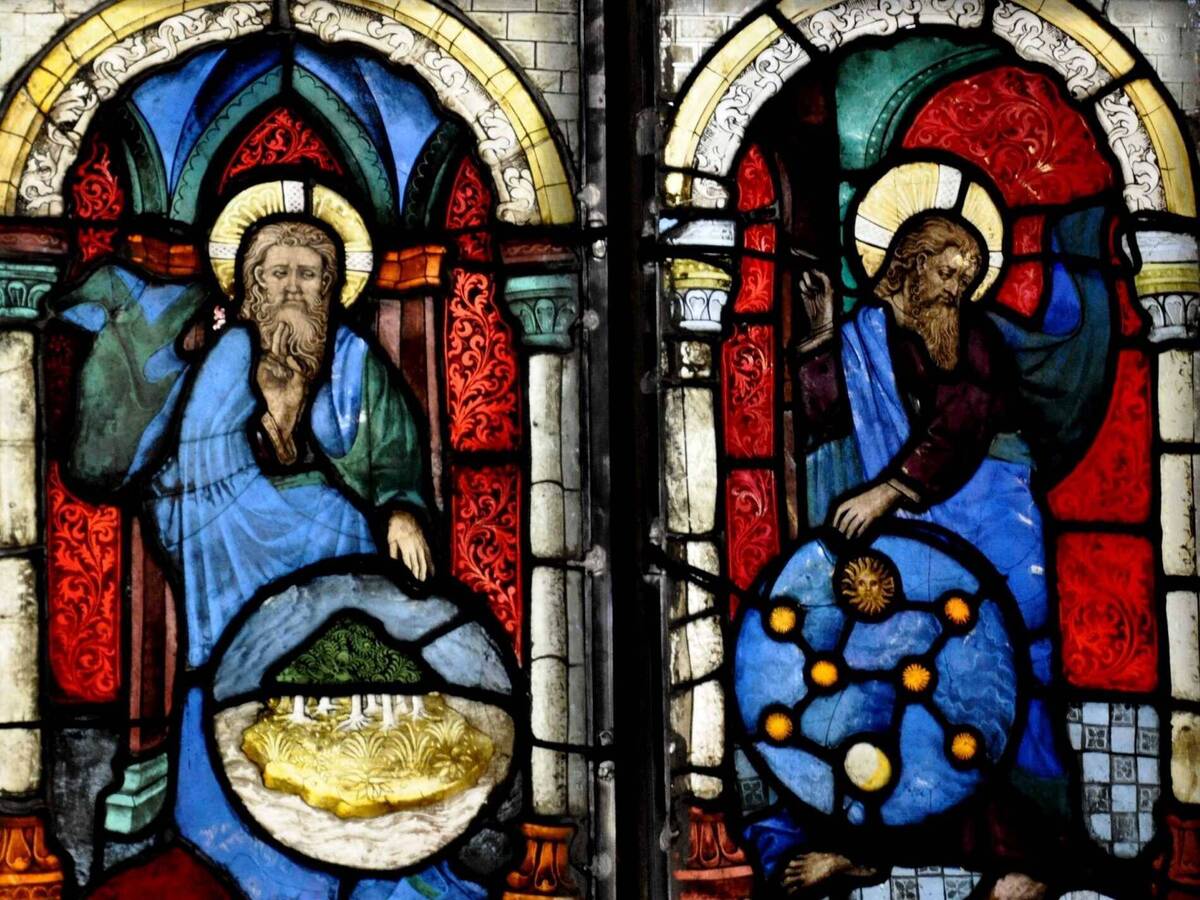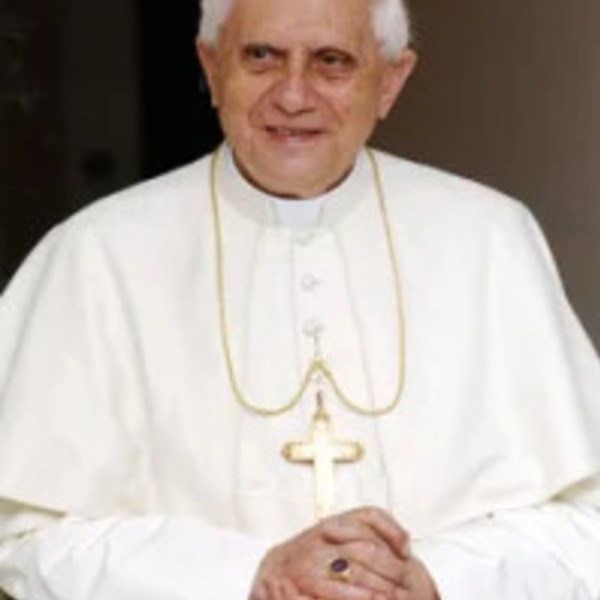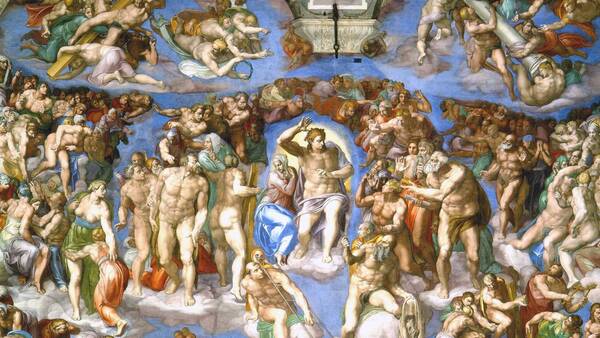In setting out to establish some standards for interpreting the creation account, and for a theological approach to interpreting Scripture in general, we have come up with two in particular: first, that Scripture is to be read as a path, in its full totality, and second, more precisely, that the Old Testament and the New Testament both light the way for each other along the totality of this path. And what this means in concrete terms for us as Christians is that we read Scripture with Christ. He is our guide through it all, and we can count on him to show us what is image, and where the true, enduring content of a biblical passage may be found.
He is at the same time, we said, our liberation from a false bondage to literalism and our guarantee of finding the best, the realistic, and not arbitrarily interchangeable truth of the Bible, the truth that does not dissipate in a fog of pious pleasantries but remains the firm ground on which we stand.
To the first, more structural of these findings—though it tells us quite a bit about God’s action throughout all of history, and the accessibility, the comprehensibility, and the perceptibility of this action—we then added a concrete conclusion, which I, however, formulated more by way of anticipation: namely, that belief in creation, as we come to understand it by reading the Bible in its totality, is reasonable. While reason might not be able to arrive at this belief on its own, it still calls out for it and finds in it the response for which it was looking and which at the same time helps it to get its own insights in order and fit them into the whole.
Reason in Creation and the Reason of God
Let us begin, first of all, with the question of the reasonableness of creation. In the first lecture [collected in The Divine Project], we were largely content to say that this text (Gen 1) tells us that God created. This “that,” of a contingent world in which nothing exists of itself and nothing can account for itself, requires that which is of itself in order to account for anything that is not of itself.
While this philosophical insight is in itself quite reasonable, by the nineteenth century, it was not seen as particularly evident at all, a view that appears to be shared by many today as well. In the nineteenth century, you see, the natural sciences were particularly informed by the two great laws of conservation, the law of conservation of matter and the law of conservation of energy. However, because of the considerable impact that the two laws of conservation had on the image that people had of nature and the world, the whole universe was presumed to be an ever-existing cosmos governed by the unchanging laws of nature, which ultimately necessitates no further hypotheses or questions, but exists of itself and in itself and has no need of anything outside of itself. It was simply there, in its entirety. This is what enabled Laplace to say that he no longer needed the hypothesis of God; that is, he said: “If we can just explain this and that, then we will not need God as a hypothesis anymore.” But it seemed they were virtually there already.
But then new discoveries were made. One of these findings was the law of entropy, which states that energy, when consumed, is transformed into a different state and cannot be restored. This means that the world follows a course of coming to be and passing away, with temporality written into its very structure. After that came the discovery that matter can be transformed into energy, and based on these two discoveries, the laws of conservation were themselves modified. Finally came the theory of relativity, and many other discoveries, all of which, when taken together, showed that the world had its own built-in timepieces, so to speak, and from these “timepieces” we can see that there is a beginning and an end, a passage of time from beginning to end. Even if the time in question spans immeasurable distances and scientists come up with ever older dates, the knowledge that cosmic existence is fundamentally temporal in nature nevertheless allows us to discern once more, through the obscurity of billions of years, that moment which the Bible refers to as the beginning. And that beginning points to the one who had the power to set existence itself into being, to say “let there be” and there was. Or, to put it another way, we once again have to distinguish between what is not necessary, that which by its very nature comes into and passes out of existence, and what is necessary.
A second thing to consider is that the more we discover of the universe, the more we find a kind of reason in it all, whose ways we try to follow. Today there is even this idea from America that is gaining steam, the hypothesis that the universe is anthropically determined—that is, that even a tiny difference in the starting conditions of the universe would have meant that man could not exist. But as things did turn out, there does seem to have been a kind of determination at play in the course that the universe ultimately followed. But be that as it may, let us go ahead and leave that hypothesis alone for now. Everything that we are learning about, from the very smallest thing to the very largest, enables us to see things anew, and the scientific formulas, as it were, are an opportunity for us to reflect on the Creator Intelligence to which our own reason owes its existence.
I always like to refer here to the still-unsurpassed words of Albert Einstein, who once said that the laws of nature reveal “an intelligence of such superiority that, compared with it, all the systemic thinking and acting of human beings is an utterly insignificant reflection.” Now it is well known that this did not lead Einstein to a concept of a personal God, and of course we are not dealing with a fully developed theology here. But what he says is nevertheless an expression of the principle that all of science rests upon, that human thought in its own meager way is able to contemplate a Reason that is forever immeasurably greater than ours, a Reason that preexists us and that also enables our own power of reason.
We are able to recognize in the immense objects that make up the world of the stars and other heavenly bodies a great and powerful Reason that holds the universe together. And as we penetrate ever deeper into the smallest of things, into the cell, into the primordial units of life, there, too, we discover a reasonableness that is truly astonishing, so that today I believe we can no longer say that Saint Bonaventure was merely being pious; rather, he was also being reasonable, when he said—very much in the tradition of the Wisdom Books, I might add—“Whoever does not see all this is blind. Whoever does not hear all this is deaf. And whoever does not begin to worship and praise the Creator Intelligence based on all this is dumb.”
Allow me to relate another instance, one from what we might call the “other side”; it is a bit of a funny story, but in my opinion it is also a powerful one. Jacques Monod, as is well known, categorically rejected any belief in God as unscientific, and in one impressive work he attributed the origin of the universe to the interplay between chance and necessity. But in this very book, which was translated from French and sums up his worldview, he relates how after attending the lectures that would ultimately form the basis for the book, François Mauriac is supposed to have said, “What this professor wants to inflict on us is far more unbelievable than what we poor Christians were ever expected to believe.”
Monod himself says that Mauriac was actually right— that it really is even more unbelievable, but unfortunately, it happens to be scientifically true. Indeed, his thesis, which we are going to come back to in the next lecture, is that “the whole concert of animate nature”—that is exactly how he phrased it—“arose entirely from errors and dissonances, loud discordant tones, which miraculously come together in a concert.” Thus, he himself admitted—and this honesty is what makes his work so impressive—that in itself such a notion is absurd; but, he insisted, the scientific method compels us to cast aside as unscientific any question that might lead in the direction of a creative Reason if there is no other way to answer it. This, I think, is where a certain definition of the scientific method is revealed to be unreasonable, and hence unscientific as well, inasmuch as science is presumably concerned with reason.
So in that regard, having seen the ramifications of this counter-experiment, as it were, we can now say, in light of everything we know, that when we observe the reasonableness of creation, what we see is God himself looking back at us. People like Manfred Eigen and others have attempted to show that random chance is reasonable, using game theory and such to explain away its very discordant nature. But I do not believe they have been able to change Monod’s diagnosis in any fundamental way. In this respect, it can be said that physics and biology, the natural sciences in general, as long as they keep within their own domain of course, do not reveal the existence of God—indeed, such a God could only be a very diminished one. Yet in the very limits to what they are able to tell us, and by those things to which they implicitly point, they have in fact provided us with what I see as a new, heretofore unheard-of creation account, one with grand, new images in which we might recognize the face of the Creator, the God who acts, reminding us all over again that at the very beginning and foundation of all being stands the Creator Intelligence. The world is not the product of darkness and senselessness. It arises from intelligence, it arises from freedom, and it arises from a beauty that is love. And seeing this, amid all the horrors of the world, gives us courage to keep living and empowers us to embark confidently on the adventure of life.
So what I wanted to do with this was to develop this line of reasoning from our previous lecture a bit further. We are still left with the ongoing task of trying to understand precisely what it means to say “God acts.” To these reflections, I would now like to add one more step, as I have already mentioned. Thus far, I have tried to make it clear that the creation accounts in the Bible represent a different way of speaking about reality than the one we know from physics and biology. And this is how they were intended, not just something we say now that we know better. They do not depict the process by which things came to be or the mathematical structure of the world; rather, what they tell us, in various ways, is that there is only one God. The world is not a battle between dark and shadowy forces but is rather the creation of one God.
The Truth Behind the Images
But this then brings us to a question that has always concerned me, even as a university student: Is this all we are left with from these chapters and from all the other creation texts in Scripture? Are we not asking the images to do too much of the work here? I would say, no, this is not all we are left with. In any case, if we recognize that these texts are primarily concerned with communicating this basic message, that does not mean that the individual passages of the biblical text—that is, the various images we find in them—now just sink into meaninglessness, leaving us, as it were, with nothing but these new images, this bare extract. The individual images express truth, too, even if they do not all do so in the same way; but again this truth is different from the kind of truth with which we are familiar from physics and biology. They express truth in the manner of symbols, much as a Gothic window is able to communicate incredibly profound things with the effect of the light passing through it and the signs and symbols that decorate it.
Now, I do want us to stay focused on a systematic approach to these issues and not get carried away with exegesis, so let me emphasize two key points here.
The first is that the biblical creation account is characterized by its use of numbers. These numbers, however, reflect not the mathematical structure of the world but, rather, the inner pattern that is woven into its fabric, so to speak—the idea upon which it is built. Predominant among them are the numbers three, four, seven, and ten; and for now I would like to focus on only two of these, seven and ten. The words “God said” appear ten times in the creation account. And since this is a very careful and deliberate account, we can say with certainty that this is no coincidence. Rather, by having God speak ten times in the creation account—ten words of God—the creation narrative already anticipates the Decalogue; that is, the Ten Commandments. In this way, it already points to the inner unity of God’s singular action in creation and history, of his singular act of speaking, thus revealing to us, in the very pattern of creation, the God who speaks for history. It allows us to see that the “ten words” that we call the Ten Commandments are, as it were, nothing less than the echo of creation. They are not arbitrary inventions meant to put up barriers to human freedom, but signs pointing to the spirit, the language, the meaning of creation. They are thus a translation of the language of the universe, a translation of the logic of God, which this world anticipates. So that is the number ten, then. The Decalogue, the Ten Commandments, are simply a translation, so to speak, of the inner Word of creation itself and of the action that emanates from it, which is present within creation and does not override our own action.
The other number, the one that dominates the whole creation account, is seven. Indeed, the schema of the seven days makes it impossible to overlook how thoroughly the entire account is shaped by this number. Seven is the number of days in a lunar phase, and thus we are told throughout this account how the rhythm of our heavenly companion reveals to us the rhythm of human life as well. It becomes clear that we human beings are not trapped within our own little “I,” but that we are part of the rhythm of the universe; that we too can learn from the heavens, as it were, the rhythm, the movement, of our own lives by attuning ourselves to the reason inherent in the universe.
I believe that this is something very important. Human existence is perpetually open to the cosmos; we are not entangled in the things of the earth, let alone our own affairs and the little bit of work that we do; rather, the whole universe is locked together in a rhythmic cycle from which we derive the rhythm of our own lives, and by taking our place in this rhythm we consummate the world as we ought.
But then the Bible takes this idea one step further. It tells us that the rhythm of the heavenly bodies is, in a deeper sense, an expression of the rhythm of the Heart that created the heavens and mankind, an expression of the rhythm of God’s love, which manifests itself in them.
EDITORIAL NOTE: This is an excerpt from Joseph Ratzinger's forthcoming, previously unpublished lectures, The Divine Project: Reflections on Creation and the Church. Used by permission of Ignatius Press, ALL RIGHTS RESERVED.


